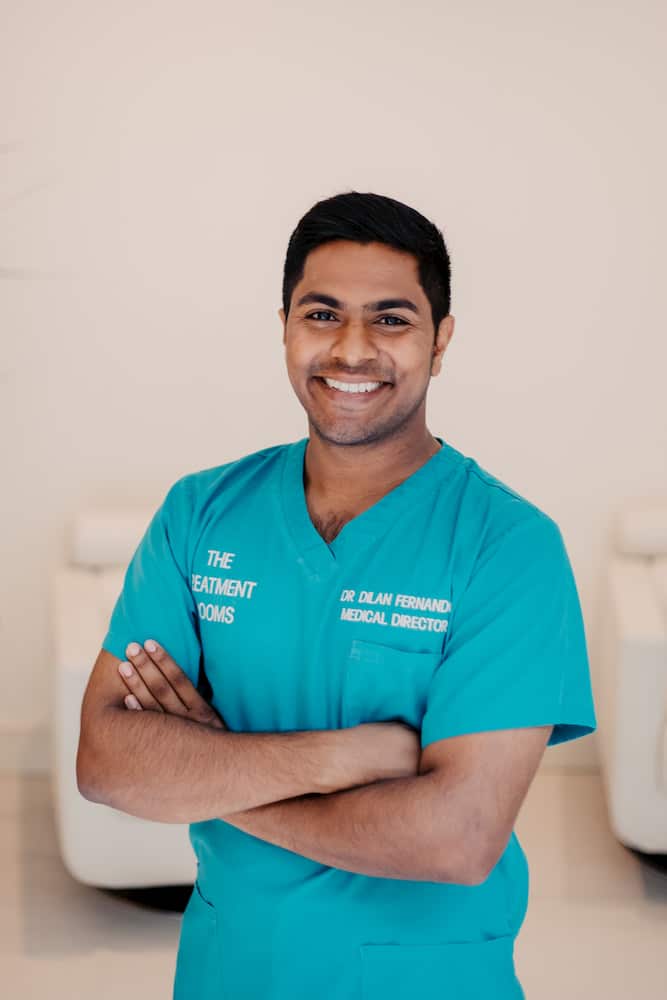7 days after your hair transplant you will see the scabs in your transplanted area washing away, leaving the newly implanted hair visible with some mild amount of redness in your skin. This is normal and an example of a patient’s recovery 7 days after hair transplant surgery is shown below.

Hair transplants are a solution for patients suffering from hair loss, with the procedure proven to help boost levels of confidence and self-esteem1. According to research, hair transplants can potentially reverse the psychosocial problems commonly associated with experiencing hair loss2.
How long does hair transplant recovery take?
Recovering after a hair transplant normally takes 1-2 weeks3. Within the immediate few days after the procedure, you may experience mild symptoms like discomfort, swelling and scabbing4, but these should all subside within a week.
Over the next few weeks and months, your newly transplanted hair may fall out, this is a normal process of surgery. By the third or 4th month, you should be able to see this new hair growth starting to come through, you can read about this process in our dedicated article: How long after a hair transplant does hair start to grow?
After a year or so, the full results of your transplant should become evident5. However, everyone is different so individual healing times can vary based on how well you perform post-operative care and adhere to your surgeon’s instructions.
Hair transplant recovery stages
While many patients are keen to see the results of their hair transplant as soon as possible, patience is key. Taking the time to understand the hair growth stages that will occur throughout your recovery can help make you aware of what to expect. These include6:
- Shedding phase (2 – 6 weeks) – this initial stage is a normal part of the hair growth cycle and is a sign that the new hairs are beginning to form.
- Latent phase (3 – 4 months) – during this stage, the transplanted hairs will remain dormant and may not be visible. However, underneath the surface, they will be preparing for the anagen (growth) phase.
- Anagen phase (6 – 12 months) – this is the active growth phase, during which time the transplanted hairs will start to emerge and thicken. While the rate of growth varies between individuals, most patients should see significant results within a year.
- Catagen phase (2 – 3 weeks) – this transitional phase marks the beginning of the end of the hair growth cycle. During this time, the hair follicle will gradually shrink in size and regress into the dermal papilla in preparation of entering the telogen phase.
- Telogen phase (3 – 4 months) – the resting phase is the final stage of the hair growth cycle. During this time, the cells at the base of the hair follicle undergo programmed cell death, becoming completely inactive and eventually shedding the hair shaft.

Since the hair growth cycle is not perfectly synchronised, many patients may experience shedding throughout the entire recovery process, rather than only a few weeks.
However, as your transplanted follicles become more established, this will gradually subside. You should then ‘be satisfied with the results’ of your hair transplant within 12 months5 and you can see hundreds of before and after hair transplant surgery cases in our gallery.
7 days after the hair transplant: what to expect
The first 7 days after your transplant will set the foundation for an easier recovery journey.
Days 1 & 2: The initial recovery
During the first two days after the procedure, you may experience some discomfort, swelling and redness around the recipient site.
While having an FUE hair transplant is minimally invasive with little postoperative discomfort, we would recommend giving your scalp time to recover by either working from home or taking up to 1-2 weeks off work.
You should also follow your surgeon’s advice and post-operative instructions diligently during these early days, avoiding harsh chemical hair dyes, sun exposure or washing your hair to reduce the risk of potential complications.
Days 3 & 4: Managing pain & discomfort
As you progress into the third and fourth days, any initial feelings of discomfort you had may start to feel more intense than before.
To manage these symptoms, your surgeon may prescribe over-the-counter pain medications and recommend certain self-care strategies.
On day four after your surgery, you will also be advised to wash your hair for the first time after your transplant. But, before you do, you will need to follow your surgeon’s recommendations and guidance to do this successfully.
This will involve avoiding rubbing your hair with rough towels or scratching your scalp. See our step-by-step hair washing guide for detailed instructions.
Days 5 & 6: Scabbing & crusting
The fifth and sixth days post-transplant mark a significant phase in the recovery process, with scabbing and crusting becoming more prominent.
While some patients find this distressing, scabbing can be normal. We would recommend washing thoroughly by day 10 to ensure these scabs start to wash away. You can read more about this topic in our dedicated article- when can you remove scabs after having a hair transplant.
Although they might be itchy, you must avoid picking or interfering with the scabs in any way, as this could damage the hair grafts. Your surgeon will be able to recommend specific shampoos or products for you to use to help reduce the itchiness of your scalp.
Day 7: Less scabbing, mild redness and the start of shedding
From the seventh day and beyond, your scabs should start to be washed away and you may notice your hair starting to fall out after having your hair transplant.
As mentioned earlier, shedding after your hair transplant is an entirely normal part of the hair growth cycle where new hair forms in the follicles and will begin to grow over the next 8–12 months. This can happen in areas of transplanted hair, non-transplanted hair and, in rare cases, the donor area itself.
While there is no proven way to reduce the likelihood of this hair loss happening, certain medications like finasteride and minoxidil can help thicken your hair8 and may be recommended by your surgeon.
Hair transplant post-operative care
Moving beyond the first week, maintaining proper post-operative care is crucial for ensuring the long-term success of your hair transplant.
This will involve keeping your scalp clean and healthy, avoiding any activities that could harm the transplanted grafts or cause you stress. We recommend waiting 2 weeks before returning to exercise and 4 weeks before returning to contact sports.
At The Treatment Rooms London, our personalised aftercare recovery packages take into account a wide range of personal requirements and contain a bundle of important medications and instructions to help you look after your transplant at home.
Get expert aftercare advice at The Treatment Rooms London
The first week after your hair transplant is a critical time that can shape your entire journey towards recovery. Therefore, being as prepared as possible can make all the difference between achieving a successful outcome and, ultimately, feeling disappointed.
Here at The Treatment Rooms London, our surgeons will always provide you with expert post-operative instructions and tailored aftercare advice to support you throughout your recovery. However, if you have any further questions, we’re only a phone call away.
Sources
- Liu, F., Miao, Y., Xingdong, L., et al. (2018) The relationship between self-esteem and hair transplantation satisfaction in male androgenetic alopecia patients. Journal of Cosmetic Dermatology. 18(5): 1441 – 1447. Available at: https://onlinelibrary.wiley.com/doi/full/10.1111/jocd.12839
- Mohebi, P. & Rassman, W. (2008) Psychology of hair transplants. Hair transplant forum international. 18(2): 46 – 47. Available at: https://www.ishrs-htforum.org/content/htfi/18/2/41.full.pdf
- Zito, P. & Raggio, B. (2023) Hair Transplantation [Updated 2023 Feb 14]. In: StatPearls [Internet]. Treasure Island (FL): StatPearls Publishing. Available at: https://www.ncbi.nlm.nih.gov/books/NBK547740/
- Kerure, A. & Patwardhan, N. (2018) Complications in Hair Transplantation. J Cutan Aesthet Surg. 11(4): 182 – 189. Available at: https://www.ncbi.nlm.nih.gov/pmc/articles/PMC6371733/
- Chouhan, K., Roga, G., Kumar, A. & Gupta, J. (2019) Approach to Hair Transplantation in Advanced Grade Baldness by Follicular Unit Extraction: A Retrospective Analysis of 820 Cases. J Cutan Aesthet Surg. 12(4): 215 – 222. Available at: https://www.ncbi.nlm.nih.gov/pmc/articles/PMC6967160/
- Hoover, E., Alhajj, M. & Flores, J. (2023) Physiology, Hair [Updated 2023 Jul 30]. In: StatPearls [Internet]. Treasure Island (FL): StatPearls Publishing. Available at: https://www.ncbi.nlm.nih.gov/books/NBK499948/
- Parsley, W. & Perez-Meza, D. (2010) Review of Factors Affecting the Growth and Survival of Follicular Grafts. J Cutan Aesthet Surg. 3(2): 69 –75. Available at: https://www.ncbi.nlm.nih.gov/pmc/articles/PMC2956960/
- Suchonwanit, P., Thammarucha, S. & Leerunyakul, K. (2019) Minoxidil and its use in hair disorders: a review. Drug Des Devel Ther. 13: 2777 – 2786. Available at: https://www.ncbi.nlm.nih.gov/pmc/articles/PMC6691938/
Share:
Authored by
Reviewed by
Book a Consultation
Related Blogs
When Can You Safely Wear a Beanie After a Hair Transplant?
July 3, 2025
Quick Summary Cap Recommendations: Light, breathable caps, such as snapbacks or trucker hats, are advisable if you need…
Castor Oil (Ricino Oil) for Hair Growth: Benefits, Uses & How to Apply for Maximum Results
June 26, 2025
Castor oil, also known as Ricino oil, is extracted from the Castor bean plant (Ricinus communis). During…
What is a Hair Transplant? How it Works, Success Rate & What to Expect
June 23, 2025
Hair transplantation is a cosmetic surgical procedure that restores hair by moving healthy follicles from one part…
John Cena Hair Transplant
May 14, 2025
John Cena, a common household name, is a figure who has effortlessly straddled the worlds of professional…
Kyle Walker Hair Transplant: Before, After, and His New Hairline
May 12, 2025
Kyle Walker is known for his defensive skills at Tottenham Hotspur, Manchester City, and in the England…
Celebrity Hair Transplants: Full Before and After Analysis
May 8, 2025
Elon Musk Hair Transplant Elon Musk, the billionaire behind Tesla and SpaceX, is well-known for his innovations…
Lewis Hamilton Hair Transplant: Before, After, and His New Hairline
May 7, 2025
As a top-class racing driver, Hamilton is used to wearing a race helmet. While this does protect…
James Nesbitt Hair Transplant: Before, After, and His New Hairline
May 6, 2025
James Nesbitt, the Northern Irish actor famed for his role as Adam Williams in the British comedy-drama…
How Many Hair Grafts Do You Need For A FUE Hair Transplant?
May 3, 2025
An Follicular Unit Excision (FUE) or FUT hair transplant are 2 main procedures available to address hair…











